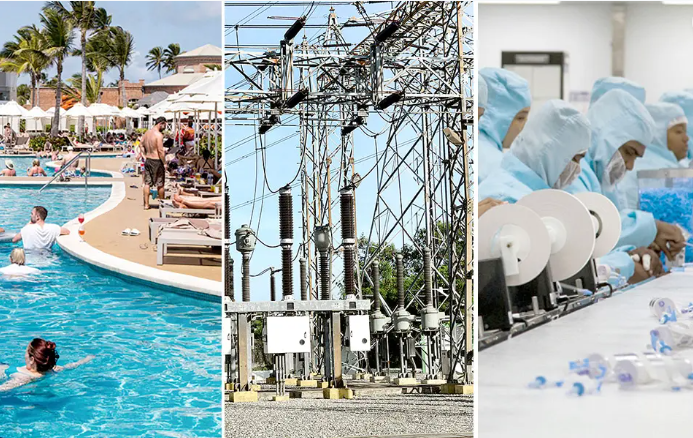In the interest of keeping economic agents and the general public duly informed, and as part of the institutional commitment to transparency and timely disclosure of data, the Dominican Central Bank (BCRD) released the preliminary results of the Dominican economy as of July 2023.
The monthly economic activity indicator (IMAE) registered a year-on-year growth of 2.9% in July 2023, showing significant improvements mainly in local manufacturing, construction, trade, transport, and agricultural activities, about the performance of these sectors in the first half of the year. This result means that the average variation of the IMAE during January-July 2023 stood at 1.4% compared to the same period of 2022, with the Hotel, Bar, and Restaurant sector with a growth of 11.9%, and the highest incidence in this result.
In particularly, the following year-on-year variation rates are observed in July: hotels, bars and restaurants sector (9.1%), financial services (6.9%), health (6.2%), real estate and rental services (5.6%), agriculture (5.1%), communications (5.9%), trade (4.7%), construction (2.1%), local manufacturing (1.6%), manufacturing of free zones (1.6%), transport and storage (0.6%), among others.
It should be noted that this result in July largely reflects the favorable reaction that the Dominican economy is having to the monetary stimuli implemented by the Dominican Central Bank since May of this year, in an environment where year-on-year inflation is within the target range of the monetary program of 4% ± 1%. Considering that the monetary policy transmission mechanism operates with lags, it is expected that these measures will continue their spillover effect by accelerating this mechanism, supporting the recovery of the economy in the remainder of the year with an improvement in the performance of the productive sectors. To this end, it should be noted that private credit in national currency grew 17.0% in July compared to the same month in 2022.
Among the measures provided is the reduction of the monetary policy rate (MPR) by 75 basis points cumulatively to July, complemented by a liquidity provision program, whereby the Monetary Board has authorized financing of around RD $ 110,000 million to date to be channeled by financial intermediation entities through loans to the productive sectors and households under favorable conditions. Specifically, resources have been disbursed to trade (RD$45,017 million), consumption and housing (RD$16,883 million), construction (RD$11,732 million), manufacturing (RD$6,990 million), health (RD$1,816 million) and agriculture (RD$1,350 million). The remaining funds have been placed for other economic activities, as well as for liquidity management and to promote the smooth functioning of the monetary policy transmission mechanism.
When analyzing the performance of the IMAE in cumulative terms during January 2023, the incidence of services as a whole stands out, constituting approximately 60% of GDP and presenting a year-on-year expansion of 3.3% in the aforementioned period. These services include foremost hotels, bars and restaurants (11.9%), health (9.2%), financial services (6.5%), communications (6.4%), real estate and rental activities (5.3%) and other service activities (4.5%).
The Hotels, Bars, and Restaurants sector showed a variation of 11.9%, with the highest incidence in the aggregate growth of the IMAE so far in 2023. This sector’s dynamism responds mainly to the external demand for the tourist services offered by the country. There have been unprecedented flows in the arrival of non-resident passengers by air, accumulating 4,879,696 visitors in January-July 2023. When including the reception of passengers by sea, which registered 1,418,750 cruise passengers as of July, the total number of visitors stands at 6.3 million, reaching a historical record according to the figures reported by the Ministry of Tourism and the Dominican Port Authority.
Agriculture registered a growth of 3.7% in real terms during January 2023, highlighting the result of July (5.1%), the highest in the first seven months of the year. The increase in the production of the main items of national consumption such as rice, bananas, chicken, and eggs, among others accounts for this sector’s performance. Fundamental to this behavior has been the appropriate measures taken by the Government, through the Ministry of Agriculture and its dependencies, to provide technical and financial support to agricultural producers nationwide and guarantee the country’s food security.
The added value of the construction industry showed year-on-year growth of 2.1% in July 2023, evidencing its recovery given the more favorable conditions seen in the conjuncture, fostered by the resource facilities made available by the monetary authorities through financial intermediaries, lower interest rates, greater execution of public capital expenditure and the stabilization of the price of the inputs used in this activity. It should be noted that this sector stands out for its great capacity to pull other economic activities along so that its reactivation would contribute to the dynamism of the national productive apparatus.
Finally, as mentioned above, it is expected that the monetary stimulus strategy, through which the Monetary Board has authorized resources to be channeled by the Financial Intermediation Entities through loans to the productive sectors and households, will continue to promote conditions to support the recovery of the economy in the remainder of the year with an improvement in the performance of the productive sectors. Thus, it is expected that these measures will continue to contribute to the dynamism of consumption and investment in activities with a broad multiplier effect on economic activity.
Source:




